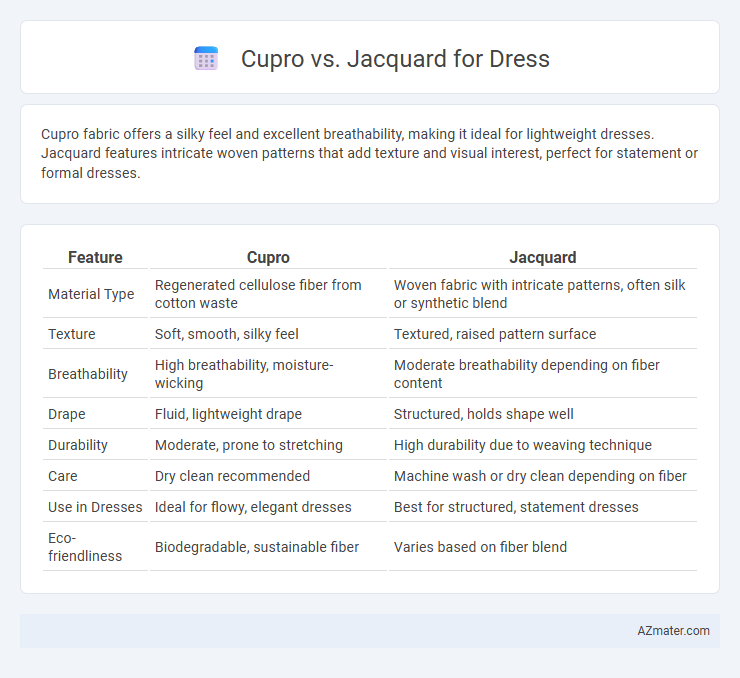Cupro fabric offers a silky feel and excellent breathability, making it ideal for lightweight dresses. Jacquard features intricate woven patterns that add texture and visual interest, perfect for statement or formal dresses.
Table of Comparison
| Feature | Cupro | Jacquard |
|---|---|---|
| Material Type | Regenerated cellulose fiber from cotton waste | Woven fabric with intricate patterns, often silk or synthetic blend |
| Texture | Soft, smooth, silky feel | Textured, raised pattern surface |
| Breathability | High breathability, moisture-wicking | Moderate breathability depending on fiber content |
| Drape | Fluid, lightweight drape | Structured, holds shape well |
| Durability | Moderate, prone to stretching | High durability due to weaving technique |
| Care | Dry clean recommended | Machine wash or dry clean depending on fiber |
| Use in Dresses | Ideal for flowy, elegant dresses | Best for structured, statement dresses |
| Eco-friendliness | Biodegradable, sustainable fiber | Varies based on fiber blend |
Introduction to Cupro and Jacquard Fabrics
Cupro fabric is a regenerated cellulose fiber derived from cotton linter, known for its silky texture, breathability, and eco-friendly properties, making it a popular choice for lightweight, comfortable dresses. Jacquard fabric features intricate woven patterns created on a jacquard loom, offering rich texture and durability with designs woven directly into the fabric rather than printed. Both materials bring unique qualities to dressmaking: Cupro excels in softness and drape, while Jacquard stands out for its detailed patterns and structural integrity.
Origins and Fabrication Processes
Cupro, derived from regenerated cellulose fibers extracted from cotton linter, undergoes a chemical process called cuprammonium treatment to create its smooth, silk-like texture. Jacquard fabric originates from the invention of the Jacquard loom, which uses punched cards to intricately weave complex patterns directly into the fabric, often utilizing various fibers such as cotton, silk, or polyester. While Cupro is a man-made fiber emphasizing a soft and breathable feel, Jacquard refers to the weaving technique that produces richly textured and patterned textiles.
Texture and Appearance Comparison
Cupro fabric features a smooth, silky texture with a lustrous sheen that drapes elegantly, making it ideal for dresses requiring fluidity and softness. Jacquard offers a richly textured surface with intricate woven patterns, providing a visually striking and tactile dimensionality that enhances garment sophistication. The choice between Cupro and Jacquard impacts dress appearance significantly: Cupro delivers sleek simplicity and subtle shine, while Jacquard showcases detailed motifs and a pronounced texture.
Breathability and Comfort Level
Cupro fabric offers excellent breathability due to its moisture-wicking properties and natural cellulose fibers, making it highly comfortable for warm weather. Jacquard, often made from synthetic or blended fibers, provides less airflow but compensates with intricate woven patterns and texture. For dresses prioritizing ventilation and softness, Cupro stands out as the superior choice, while Jacquard excels in style and structure.
Durability and Longevity Factors
Cupro fabric, made from regenerated cellulose fibers derived from cotton linter, offers moderate durability but tends to wear out faster due to its delicate structure and sensitivity to abrasion and detergents. Jacquard, woven with intricate patterns from high-strength fibers such as polyester or cotton blends, ensures superior longevity and resistance to wear, making it ideal for dresses requiring long-term durability. The dense weave and strength of Jacquard fibers contribute to maintaining dress shape and appearance through repeated use and laundering.
Eco-Friendliness and Sustainability
Cupro, a biodegradable fabric made from regenerated cellulose fibers derived from cotton linter, offers high eco-friendliness due to its closed-loop production process that recycles water and chemicals. Jacquard, often woven from synthetic fibers or blends, generally has a larger carbon footprint due to energy-intensive manufacturing and non-biodegradable components. Choosing Cupro over Jacquard for dresses supports sustainable fashion by minimizing environmental impact and promoting renewable resources.
Ease of Care and Maintenance
Cupro fabric offers superior ease of care due to its machine-washable nature and resistance to shrinking, making it ideal for everyday dress maintenance. Jacquard, with its intricate woven patterns, typically requires gentle hand washing or dry cleaning to preserve its texture and design quality. The durability of Cupro allows for hassle-free cleaning routines, while Jacquard demands careful handling to maintain its aesthetic appeal over time.
Suitability for Dressmaking
Cupro fabric offers excellent breathability and a silky texture, making it highly suitable for lightweight, flowy dresses that require comfort and elegance. Jacquard features intricate woven patterns and a heavier weight, ideal for structured dresses that demand visual interest and durability. Choosing between Cupro and Jacquard depends on the desired dress silhouette and the occasion, with Cupro favored for casual or summer wear and Jacquard preferred for formal or statement garments.
Price and Accessibility
Cupro dresses typically feature a higher price point due to the costly and labor-intensive manufacturing process involving regenerated cellulose fibers, making them less accessible to budget-conscious consumers. Jacquard dresses, often machine-woven with complex patterns and available in various fabric blends, tend to be more affordable and widely accessible in both fast fashion and luxury markets. The price difference largely reflects the production technique and material sourcing, with Cupro offering a silk-like feel while Jacquard emphasizes intricate texture and design versatility.
Final Verdict: Choosing Between Cupro and Jacquard
Both Cupro and Jacquard fabrics offer unique qualities for dressmaking, with Cupro providing a silky, breathable texture ideal for lightweight, elegant garments, while Jacquard features intricate woven patterns perfect for structured, statement dresses. Cupro excels in drape and softness, making it suitable for fluid silhouettes, whereas Jacquard's durability and textured designs lend sophistication and visual interest to formal attire. For choosing between the two, prioritize the desired dress style and occasion: select Cupro for comfort and a smooth finish or Jacquard for rich texture and bold patterns.

Infographic: Cupro vs Jacquard for Dress
 azmater.com
azmater.com